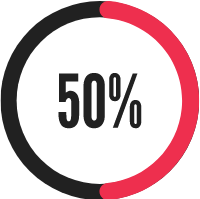
E-Commerce Statistics
To Know In 2024
The impact of technology on day-to-day life continues to grow with no signs of slowing down. While the e-commerce industry isn’t new by any means, the rapidly increasing impact of social media, among other factors, has elevated the market to new heights.
The convenience factor of online shopping is just one of the many elements that will contiue to change the shopping habits of the average consumer.
Key Highlights:
- In 2024 E-commerce will share 20.8% of all retail market.
- E-commerce sales are expected to surpass $8.1 trillion during 2026
- E-commerce websites will take up 22.3% of total retail sales
- China remains as the biggest marketplace for E-commerce, followed by the U.S.
- Emails have the highest return of investment in digital marketing.
- 87% of shoppers research online before making a purchase.
- Mobile shopping is responsible for 63% of all e-commerce sales.
- 95% of all shopping will be done online by 2040.
- There are currently 12 to 24 million e-retail stores globally.
General E-commerce Statistics
The e-commerce market worldwide has been developing at different rates, which is expected considering the number of factors that influence this market. Globally however, statistics reflect trends that are most likely to see a similar growth pattern.
24 million e-retail stores worldwide
And more sites like these get created every day, making the market quite competitive. However many can't survive the industry’s pace.
33% of the world shops online
Recent data shows that this number of over 30% of the world population is shopping online for different goods and services.
205 million daily online shoppers
In one day alone, this many people worldwide turn to online shopping to fill their needs for a wide variety of products.
$5.7 trillion global value
The e-retail industry generates a staggering amount of money. The value of this unstoppable juggernaut is estimated at over $5.7 trillion globally.
28% don't have a website
Even though online presence has become indispensable in this day and age, a big number of American small businesses do not have a website.
Conversion rate sits at 2.5%-3%
Even though e-retail sales have increased, the conversion rate of clicks on the products presented to purchases made still remains at a low percentage.
E-commerce Share of Worldwide Retail
The share E-commerce has had as part of the entire retail value has had a tremendous increase in the last few years, due to many factors, with the pandemic being the most prevalent one. Globally statistics indicate a continued growth in the upcoming years.
The global e-commerce sales for 2023 surpassed $6.5 trillion for all the products sold online.
Going back to 2020, e-commerce sales globally jumped to $4.2 trillion. Meanwhile, in 2022, the global trend continued, causing online sales to culminate in an estimated 2.64 billion online shoppers worldwide, and $5.7 trillion in revenue.
E-commerce revenue
in the US, 2022-2024

Countries with the Highest E-Commerce Revenue
China currently holds first place for e-commerce revenue, with $1,54 trillion generated in 2022. In second place, the US e-marketplace generated an income of $870.78 billion. Japan follows suit in third place with $128 billion, followed by the United Kingdom with $118 billion and Germany takes the fifth place with $109 billion generated throughout 2022.
*France also includes French Guiana, an oversees department of France, located on the northern coast of South America.
E-mail E-commerce Statistics
Due to their usage throughout the years, emails remain as one of the most crucial online communication channels, be it for personal use, business, or in this case, marketing. Because of these factors, emails are one of the most profitable forms of marketing.
Out of all marketing tactics, emails have the highest return of investment (ROI), which means that investing in email marketing yields the best results of clicks turning into profit.

80% of adults use e-mail
And that's for the U.S alone. On a global scale, there are 4.26 billion e-mail users, which makes up about 53% of the earth’s population.

61% prefer to be contacted by brands via e-mail
One of the reasons e-mail marketing is so effective is because consumers tend to prefer it to be the main way of being reached out to by brands.

347.3 billion e-mails daily
Is the estimated number of e-mails that will be sent in 2023. This is no surprise considering the large number of e-mail users worldwide.

60% have purchased as a result of e-mails
E-mails have an incredible ROI. For every $1 spent, there's an average return of $44. This makes e-mails the most effective digital marketing tool.
The most profitable emails tend to be those of a transactional nature. Transactional emails are appealing because they reach out to consumers based on their preferences and interactions with the brand, compared to generalized marketing emails, which don’t take those factors into account.
As a result, transactional emails get 8x more opens and generate 6x more revenue compared to any other form of email marketing.

Personalized emails have a 26% higher chance of being opened
Understandably, personalizing emails as part of the marketing campaign is vital. The subject line is another key factor in a successful marketing campaign, in fact 47% of people decide which emails they open based on the subject line.
The emails that tend to receive some of the most clicks are emails on abandoned carts. They have an opening rate of 49% on average.
Social Media E-commerce Statistics
For better or worse social media has permeated every facet of day to day life, including the way consumers interact with retailers. Social media provides the ideal opportunities for revenue generated from user interactions and word of mouth.
Before taking the steps towards purchasing something, about 87% of shoppers research online, approximately 74% of all consumers get informed on social media about the best possible purchasing options.
It’s no surprise that the influence of social media is more prominent among the younger generations.
Hence the social marketing is the strongest and most effective for those age brackets respectively.

Half of adult social media users between 18 and 34 will make a purchase through social media throughout their lives.
Online retailers who have active social media accounts and campaigns see a 32% increase in sales compared to those retailers who do not.
And even industry professionals now realize the potential of social media in terms of sales; 19% of them are increasing their budget for social media advertising.
The influencer market has slowly but surely begun to replace traditional advertisement as a cheaper and more effective alternative.
Social media posts that feature photos tend to get better engagement. Posts with images produce 650% higher engagement than text-only post. Moreover, Visual content is 40 times more likely to get shared on social media than other types of content.
Average Instagram Statistics
48,000 likes per second
2.4 billion monthly active users
The average order value from consumers
directed from Instagram ads is $65
It goes without saying that the most influential social media today also happen to be the ones that generate the most revenue from the products they advertise. Instagram’s lead is then followed by Facebook with $55, Twitter with $46, and YouTube with $38.
According to Instagram Trends Research Study, 44% of the people participating in the study use the Instagram app to shop weekly by using features such as shopping tags and the shopping tab.
It’s estimated that there’s 130 million Instagram users that click on shopping posts each month.
Mobile E-commerce Statistics
Nowadays, most of the interactions in the online space have moved over to mobile exchanges, where users can keep in touch with those around them, and global events at the same time.
Smartphones have contributed immensely to the phenomenon of online shopping, and this is also reflected in the ever-changing shopping behavior of customers everywhere.
75% of users prefer mobile friendly sites
Mobile optimization is crucial for every website intending to make a profit. Even Google statistics detail the preference for such a commodity worldwide.
96% of users come across non mobile optimized sites
Despite the clear preference for access to sites made for mobile browsing, there's a long way to go for businesses and optimization .
67% would purchase from a mobile optimized site
Furthermore, 74% of users would revisit a site that provides a good mobile experience during browsing. Significant revenue is lost due to lack of optimization.
63% of all retail traffic is now due to mobile shopping
Mobile shopping rules the market share of e-commerce with 63%.
Global Trends
The future looks very promising for the e-commerce market if the current tendencies are of any indication. Strategies and marketing techniques continue to evolve and are expected to reach new levels in the coming years and decades.
These trends and techniques are often adaptable with the consumers and aim to provide the best customer services and increase revenue for the businesses.
93.5% Have Purchased A Product Online
A number valid for those who have access to the internet. With internet access expected to grow in the coming years, this percentage is expected to rise as well.
95% Of Shopping Will Be Done Online
Experts predict that if trends continue with the same pace, by 2040, 95% of all purchases, regardless of their nature, will be made exclusively through online retailers.
E-Retail Will Reach 22% For All Sales In 2023
E-commerce has consistently taken a larger portion of all global retail sales year by year. Indicators point that this growth will most likely continue well into next year and beyond.
A big problem for online businesses everywhere is the high cart abandonment rate. The rate of shopping cart abandonment stands at around 70% of online shopping carts everywhere.
Out of 49% of the cart abandonment emails that are opened, only 21% of them get clicked on, and out of those that click on them, only 50% finish their purchase.
Many companies have been incorporating an omnichannel approach in their marketing strategies. This technique includes having multiple channels through which marketing can be done and incorporating all of these channels into one seamless strategy that aids the consumer journey.
Besides providing multi-channel opportunities for potential buyers to come across, personalization and optimization are important facets for a successful marketing campaign. On average, businesses have lost $756 billion in potential revenue because of poor e-commerce personalization.
Chatbots are one of the emerging technologies that improve the user experience. About 50% of shoppers say they would be willing to purchase from a website with a chatbot.
While there’s uses for them in multiple fields, sales however remain as the industry with the most prevalent use for chatbots.
Younger generations prefer digital self-serve tools as means of receiving information. Around 60% of consumers consider these options as their first choice.
What's to expect next?
The reign of online shopping shows no sings of stopping. As the predictions have already given a clear indication into what is expected in the coming years, the best course of action is to embrace the shift from brick and mortar to online only.
New technologies will emerge in the future, thus further changing and shaping the e-commerce landscape. The ability to adapt to changes will determine the success of those investing in the future of retail as a whole.